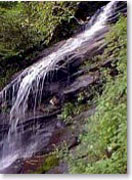“Blue Over The Blue Ridge Parkway”
Out To Pastoral
by John Idol
 HILLSBOROUGH, NC—(Weekly Hubris)—7/26/10—Making peace is something that we, as a nation, don’t do well. Making war, the more the better, as I shall document in a future column, defines our character as tireless warriors, always bruising for a fight, be the cause little or great.
HILLSBOROUGH, NC—(Weekly Hubris)—7/26/10—Making peace is something that we, as a nation, don’t do well. Making war, the more the better, as I shall document in a future column, defines our character as tireless warriors, always bruising for a fight, be the cause little or great.
Keeping the military-industrial complex in high gear means letting other things slide, things like infrastructure, schools, cultural activities, and parks. We think it better to build a remotely controlled drone than house the homeless, feed starving children, prosecute deadbeat husbands, or provide protection for abused women.
War games must go on, even if they show us betraying our democratic ideals in order to prop up a sycophantic dictator or plutocrat. They must go on because we want to market munitions to our armed forces and to foreigners looking to beef up or modernize their military gear. They must go on even if they are fought in countries opposed to our being there as self-proclaimed liberators.
If we were less bellicose, we’d push Congress until “America the Beautiful,” by Katharine Lee Bates, became our national anthem, rejecting Francis Scott Key’s militaristic boasting and accepting a poem that celebrates the nation’s beauty and profoundest aspirations. Accepting, too, a song that citizens can sing without dropping out mid-song or going falsetto.

In our bellicosity, we pay far too little heed to the beauty of America. A case in point is the Blue Ridge Parkway.This scenic parkway stretching through parts of Virginia and North Carolina attracts millions of visitors every year, affording them a means of enjoying close communion with nature and many of its wonders.
In recent years, underfunding of this scenic route has resulted in sharp cutbacks in maintenance personnel and postponement of repairs to roads, trails, and overlooks.
I offer a representative case of neglect—the trail leading to and from cascades near my native community of Deep Gap, North Carolina.
As a boy of six or so, I remember riding in the back of Uncle Walter Greene’s pick-up one Sunday afternoon over graveled roads to see the waterfall. The Parkway was then under construction, raw banks of earth exposed as the road climbed from the swag of Deep Gap to the crest of Moretz Mountain and then followed the ridge to a parking lot near the cascades.
A trail had been cut through the woodland surrounding the cascades, and safe viewing spots erected for visitors near the falls, which tumbled down hundreds of feet. So precipitous was the spill of water over exposed granite that I stood chilled by the spray drifting to my face and hands.
Over the years, I showed off this wonder to guests from many places around the nation, walking with them through well maintained trails and stopping to read with them the placards identifying flowers, shrubs, and trees.
Just this past year, at age 76, I decided I would return to the cascades, thinking that my arthritic knees would hold out long enough for me to make the steep descent along the mountain side and the tough climb back to my car. They did.
But I walked that trail with a heavy heart. Years of neglect had left the descent especially challenging. Logs placed to keep soil from washing away were decaying. Stones once serving as steps had been loosened by rains and gave only treacherous footing, and branches from trees and shrubs intruded into the pathway. Identifying markers were often grimy or bent to the ground. A trail once a source of great pleasure had become an obstacle course.
Back at last to my car, I rubbed my aching knees and reflected on happier times on the Parkway: roaming the fields looking for strawberries, fields once planted in corn, cabbage, potatoes, or buckwheat; fields now in a transition state between serving as farmland and becoming part of a buffer to retain the pastoral beauty of the Blue Ridge landscape; remembering using the Parkway as a lovers’ lane and watching the moon rise or seeing stars without the interference of city lights; recalling the springtime burst of color when mountain laurel and rhododendron bloomed.
But not all my memories were happy ones. I unrolled the coil of pictures in my mind and saw all too vividly the ugly scar left on Moretz Mountain when, in the flood of August, 1940, three or more acres of forest slid down the western slope and carried trees, rocks, and dirt several hundred feet down the Parkway and deposited them on US Highway 421. Still uglier was the picture my mind created when my sister told me of an attempted date-rape in the parking lot at the cascades. Luckily, the girl’s screams brought other less hormone-driven lovers to her rescue.
Now, as I see the effects of neglect and underfunding, I think of an axiom I gleaned from a lecture by longshoreman-philosopher, Eric Hoffer. He argued that the great nations of the world are those maintaining themselves. They must keep at the job or repairing, restoring, renewing even as they expand, he insisted.
When a bridge collapses in Minnesota, levees break in Louisiana, acid smog kills trees along the Blue Ridge or in the Great Smokies; when foreign language classes aren’t offered in our elementary and high schools, when art and music are booted from school offerings, and when a thousand and one thing more suffer from neglect and underfunding, I can’t help being blue. I can’t help lamenting our bellicosity.
For the Blue Ridge Parkway, I end with the hopeful news that it may regain some of its beauty and majesty: in celebration of its 75th birthday, Congress just approved roughly $80 million to help restore it. One provision of the appropriation is that part of the money be used to acquire more land lying adjacent to the Parkway. That’s good because already some lovers of pastoral views have built McMansions in sight of the road, construction entirely out of keeping with the aesthetic spirit of the route. That appropriation, coupled with funds raised by Friends of the Blue Ridge Parkway, leaves me, today, a lighter shade of blue.